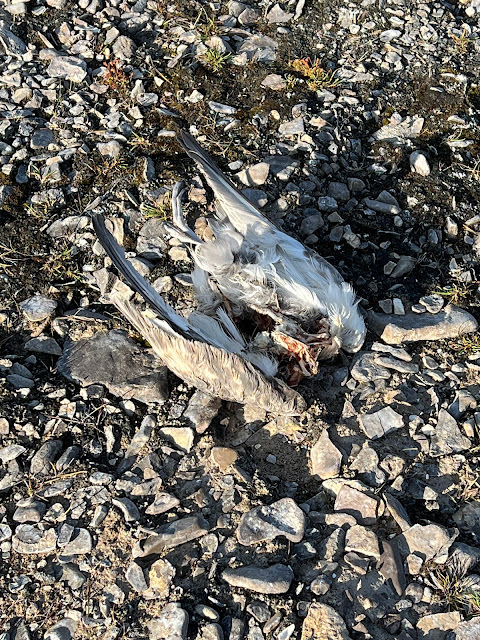 |
| The kayakers made wee colourful splashes in the background |
This morning we anchored in Maxwell Bay and went ashore (Lindsay still nursing injuries stayed on board ship). Some people went off hiking. Me? I did one of my favourite things - beachcombing. It would have been perfect if I’d been alone. Not possible of course with bears on the prowl, but fortunately there was only a small group of us. I found flowers, moss and wee Arctic trees, tufts of qiviut snagged by vegetation (the soft undercoat of the musk ox) and the kind of stuff you often find on many beaches. Scattered around in patches were small clamshells indicating that walrus had probably been there.
 |
| Maxwell Bay |
The beach was sloping loose small shale stones and was very slippery so was very hard to walk on particularly tackling many Kms in great clumping gumboots. And to top it off the tundra was sucking mud in many places, so our legs certainly got a workout, but it was an absolutely marvellous, magic few hours.
 |
A young fulmar taken out by a Pperegrine Falcon probably -
there were feathers everywhere |
 |
| A small forest of Arctic Willow. The fluffy things are the seedheads |
 |
| A little piece of Arctic Willow bleached white by sea and sun |
 |
| Dainty Tufted Saxifrage pushing through the rocks |
 |
| Top: tiny Tufted Arctic Saxifrage. Centre: Bog Sedge. Bottom: Arctic Willow |
The environment looks harsh but everywhere life burst out between the rocks and over the ground forming a cushiony mat. We found bear footprints as well as Musk Ox hoof prints in the mud. A bear print had been spotted early by the scouts so we went prepared with equipment to make casts.
 |
Making plaster casts which were then marked with small Inukshuk (piles of stones).
The moulds came out pretty good. |
 |
| Polar bear footprint and cast |
 |
| Musk ox hoof print and cast |
 |
| Human (moi!) gumboot imprint! |
And talking of footprints I got comprehensively stuck almost up to my knees in the mud on the tundra and had to be hauled out. The end of my walking pole is still down in there! Someone will find it one day and wonder what on earth .....
 |
| NASA’s satellite images - part of their GLOBE project |
One of our citizen science projects is making cloud observations to coordinate with NASA’s satellite images (part of their GLOBE project) - it is time and location dependent. GLOBE stands for the Global Learning and Observations to Benefit the Environment Program. It is an international science and education program that anyone worldwide can participate in. One of our guides was alerted to when a satellite would be passing over and a group of us would then go out on deck (or in a zodiac!) and make cloud observation and take photos at different sky levels. We then uploaded our on-the-ground measurements to the website for the scientists to compare with what the satellites saw at the same moment. Yesterday NASA reported that we got a match with one of our observations! We were quite excited.















No comments:
Post a Comment